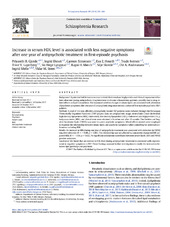Increase in serum HDL level is associated with less negative symptoms after one year of antipsychotic treatment in first-episode psychosis
Gjerde, Priyanthi Borgen; Dieset, Ingrid; Simonsen, Carmen Elisabeth; Hoseth, Eva Zsuzsanna; Iversen, Trude Seselie Jahr; Lagerberg, Trine Vik; Lyngstad, Siv Hege; Mørch, Ragni Helene; Skrede, Silje; Andreassen, Ole Andreas; Melle, Ingrid; Steen, Vidar Martin
Peer reviewed, Journal article
Published version

Åpne
Permanent lenke
https://hdl.handle.net/1956/17978Utgivelsesdato
2017-07Metadata
Vis full innførselSamlinger
Originalversjon
https://doi.org/10.1016/j.schres.2017.10.042Sammendrag
Background A potential link between increase in total cholesterol and triglycerides and clinical improvement has been observed during antipsychotic drug treatment in chronic schizophrenia patients, possibly due to drug related effects on lipid biosynthesis. We examined whether changes in serum lipids are associated with alleviation of psychosis symptoms after one year of antipsychotic drug treatment in a cohort of first-episode psychosis (FEP) patients. Methods A total of 132 non-affective antipsychotic-treated FEP patients were included through the Norwegian Thematically Organized Psychosis (TOP) project. Data on antipsychotic usage, serum lipids (total cholesterol, high-density lipoprotein (HDL) cholesterol, low-density lipoprotein (LDL) cholesterol and triglycerides (TG)), body mass index (BMI) and clinical state were obtained at baseline and after 12 months. The Positive and Negative Syndrome Scale (PANSS) was used to assess psychotic symptoms. Mixed-effects models were employed to examine the relationship between serum lipids and psychotic symptoms while controlling for potential confounders including BMI. Results An increase in HDL during one year of antipsychotic treatment was associated with reduction in PANSS negative subscores (B = − 0.48, p = 0.03). This relationship was not affected by concurrent change in BMI (adjusted HDL: B = − 0.54, p = 0.02). No significant associations were found between serum lipids, BMI and PANSS positive subscores. Conclusion We found that an increase in HDL level during antipsychotic treatment is associated with improvement in negative symptoms in FEP. These findings warrant further investigation to clarify the interaction between lipid pathways and psychosis.
